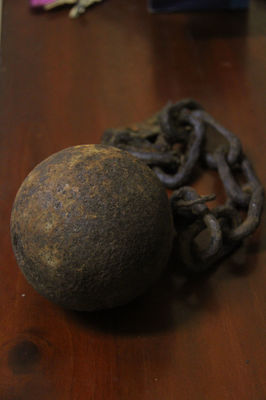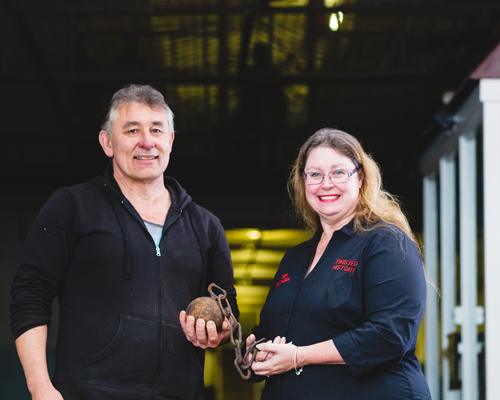By Luke Voogt
A rusted ball and chain found in Bannockburn could be a clue in one of Geelong Gaol’s greatest escapes, according to an historian.
The historic prison restraint was likely tethered to the leg of one of two convicts during their daring escape in the late 1880s, said Geelong Gaol historian Deb Robinson.
“It’s very clearly a ball and chain used in the penal system,” she said.
“I don’t think it could be anything else.”
Described as “Geelong’s hardest convicts”, Frederick Clarke and Christopher Farrell fled the gaol on 8 October 1889.
“This wasn’t the first time they’d escaped,” Ms Robinson said.
“Both of them would die in the gaol as very old men – Clarke in 1895 and Farrell in 1904.”
Ms Robinson said both were in their 60s when they escaped Geelong Gaol, which housed sick or elderly prisoners.
“These are two of our favourite escapees. They were shifty old buggers – they knew how to play the system.
“They look like kindly old grandfathers – you wouldn’t think of them as hardened criminals.”
Farrell was in gaol for attempting to shoot a police officer and Clarke was convicted of breaking and entering, Ms Robinson said.
Clarke, who worked in gaol as a blacksmith, melted coins to make a skeleton key, Ms Robinson said.
“He was able to commit the guard’s key to memory.
“He was a very crafty old man, this one.”
Clarke called for a glass of water to begin the escape.
As the only warden on duty fetched the drink Clark unlocked his and Farrell’s cells before returning to his own.
When the warden returned they gagged him, tied his hands and walked out of the gaol.
The convicts spent two weeks on the run from Geelong through Bannockburn to Ballarat.
Ms Robinson believed at least one shed the ball and chain at Bannockburn, where it lay buried for more than a century.
Newcomb’s Paul Aszenbrenner discovered the rusted artefact while helping excavate at a farm.
The suspected gaol relic emerged hanging from the teeth of a Bobcat, he said.
“It was lucky it caught my eye otherwise it would have been thrown away and buried again.
“I sort of took it home and … didn’t think much more of it.
Four years later Ms Robinson met Mr Aszenbrenner.
She immediately thought of the two escaped convicts when he mentioned his discovery.
“We know that’s where they headed,” she said.
“It’s a great artefact. It just adds to the rich convict history of area.
“Even if the chain didn’t belong to them I still think it has to be related back to the gaol somehow.”
Mr Aszenbrenner agreed.
“There are not too many other escapees, so it’s a pretty darn good chance it was them.”








